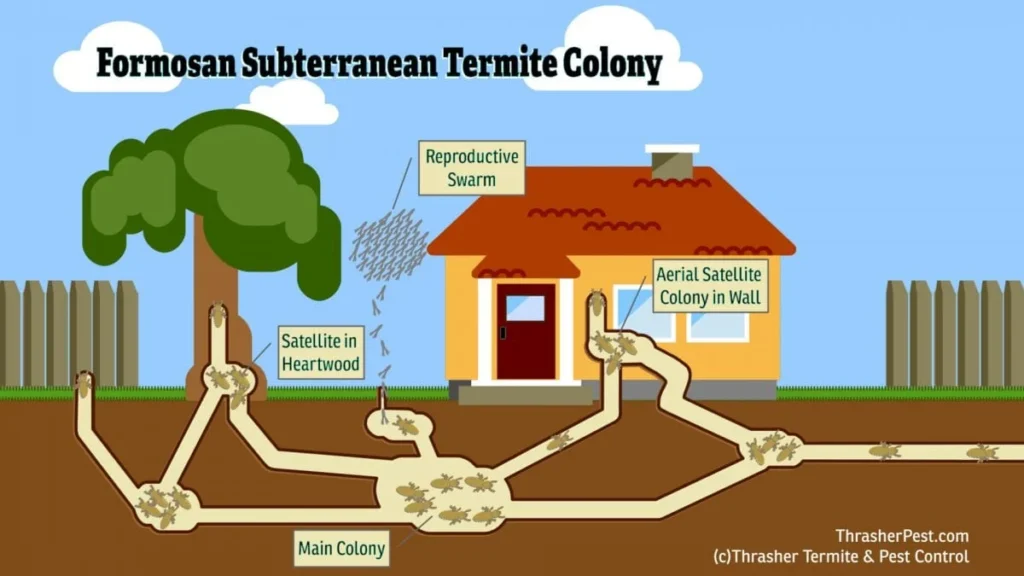
Introduction
Termites can cause significant damage to wooden structures, and what makes them especially dangerous is how quietly they operate. These pests often go undetected until the damage is already done. While traditional chemical treatments have been a mainstay of termite control for decades, modern homeowners are increasingly turning to bait systems as a more targeted and environmentally mindful option.
Termite bait systems offer a strategic approach that not only addresses existing colonies but also helps prevent future infestations. Understanding how these systems work provides insight into why they’ve become an essential part of pest control plans across the country.
In this guide, we’ll break down the components, science, and application of termite bait systems—step by step—so you can see how they function and why they’re considered a smart option for effective termite control.
The Concept Behind Termite Bait Systems
Termite bait systems are built on a simple principle: lure termites to a specific site and eliminate the colony from within. Unlike repellent barriers that attempt to keep termites out, bait systems are designed to attract termites in order to distribute a slow-acting toxicant throughout the colony.
This strategy focuses on the social behavior of termites. Because they feed one another through a process known as trophallaxis, a baited termite becomes a vector for spreading the active ingredient to others, including the queen. The result is colony collapse without the need to saturate an area with chemical pesticides.
Key Components of a Termite Bait System
A typical bait system includes the following elements:
1. Monitoring Stations
These are plastic or composite cartridges placed in the soil around a property, spaced at regular intervals. Initially, these stations contain only non-toxic materials like wood or cellulose to detect termite activity.
2. Bait Cartridges
Once termite activity is confirmed in a monitoring station, it’s replaced with a bait cartridge containing a slow-acting toxicant. The bait is typically formulated with cellulose, making it attractive to foraging termites.
3. Active Ingredient
Most termite baits use insect growth regulators (IGRs) such as hexaflumuron or noviflumuron. These disrupt the termites’ molting process, preventing them from maturing. Since termites molt several times over their lifespan, the active ingredient works gradually, allowing enough time for it to spread through the colony.
4. Protective Housing
Each station is enclosed in a weather-resistant casing that sits just below ground level. This design protects the contents from the elements and makes them easy to inspect and replace.
Installation Process
The installation of a bait system follows a systematic approach designed to intercept termites as they forage for food:
- Assessment: A professional conducts a property inspection to identify risk zones and determine optimal spacing for the stations.
- Placement: Stations are installed every 8 to 10 feet around the perimeter of the home. In some cases, interior stations may also be placed if there’s evidence of indoor activity.
- Baseline Monitoring: Initially, stations contain only monitoring materials. Professionals check them every few weeks to detect signs of termite presence.
- Baiting Phase: If activity is observed, bait cartridges replace the monitoring materials. The toxic bait is then consumed and carried back to the colony.
- Ongoing Monitoring: Regular inspections continue to ensure colony elimination and reapplication if necessary.
Advantages of Termite Bait Systems
Homeowners and pest control professionals in Orange County appreciate bait systems for several reasons, many of which align with broader pest control and environmental goals.
1. Minimal Chemical Use
Bait systems apply toxicants only when and where termites are present. This localized approach reduces the overall volume of chemicals released into the environment compared to full-soil barrier treatments.
2. Colony-Level Elimination
Instead of targeting individual termites or isolated infestations, bait systems work at the colony level. This approach increases the chances of full eradication over time.
3. Non-Invasive Installation
No drilling into foundations or trenching around buildings is required for installation. The stations are placed in the soil, causing minimal disruption to landscaping or structures.
4. Continuous Protection
Even after the initial colony is eliminated, the monitoring stations remain in place as a long-term prevention strategy. Regular inspections ensure early detection of any new termite activity.
Common Questions Homeowners Ask
Q: How long does it take for a bait system to eliminate a colony?
A: It varies based on the colony size, location, and time of year. In many cases, noticeable reductions begin within a few weeks, with full elimination achieved in several months.
Q: Will I see dead termites around the stations?
A: Not usually. The bait works gradually and is designed to prevent alarm within the colony. Termites return to the nest before dying, which helps the toxin spread undetected.
Q: Can bait systems protect against all types of termites?
A: Bait systems are primarily effective against subterranean termites, which are the most common and destructive in many regions. Drywood termites may require other treatment methods, as they live entirely within wood.
Q: Do bait systems replace the need for other termite control methods?
A: In some cases, yes. However, in high-risk or severe infestations, professionals may combine bait systems with other approaches for comprehensive coverage.
When Termite Baiting Makes Sense
Bait systems are particularly well-suited for:
- Homes with known termite activity
- Properties with difficult soil conditions that limit traditional treatments
- Homeowners seeking low-impact or environmentally conscious pest control solutions
- Areas with repeated infestations or close proximity to untreated wood or vegetation
It’s important to recognize that no single solution fits every home. Bait systems are just one tool in the broader arsenal of termite control strategies.
Professional Monitoring Is Key
For a termite bait system to be effective, regular monitoring is essential. Homeowners should not expect results from a one-time application. A pest control professional will ensure that baits are placed correctly, replaced as needed, and functioning as intended throughout the year.
Brands like CURA Termite & Pest Control often include baiting systems as part of broader pest management programs, ensuring homes are protected from termites with precision and care.
Conclusion
Termite bait systems represent a modern, science-backed method of controlling subterranean termites at the source. By leveraging termite behavior and biology, these systems deliver targeted, long-lasting results without the widespread chemical use associated with traditional treatments.
Understanding how bait systems work empowers homeowners to make informed decisions about their termite control strategy. When combined with expert oversight and regular inspections, baiting offers a proactive path to protecting your home from one of nature’s most persistent and destructive pests.
For those exploring sustainable and effective termite control options, professional guidance paired with a well-maintained bait system can offer peace of mind and real results.







